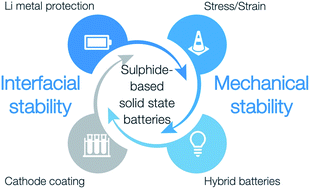Mechanical vs. chemical stability of sulphide-based solid-state batteries. Which one is the biggest challenge to tackle? Overview of solid-state batteries and hybrid solid state batteries
Abstract
Solid-state batteries using sulphide-based solid electrolyte materials are believed to be the ideal solution for next generation electrochemical energy storage. A deeper investigation of those systems revealed several challenges to be tackled or at least buffered to hope for future commercialisation. Among them, we reported the interfacial one and the mechanical one. For the former, several solutions were proposed and adapted from the knowledge acquired in Li-ion technology. For the latter, it was only sporadically studied but it reveals a real challenge for solid-state batteries since mechanical know-how (implying wettability processes on solids) was not really acquired in conventional Li-ion batteries and thus solutions from scratch need to be developed. Based on the aforementioned issues, it seems logical to develop hybrid solid-state batteries (combining polymer electrolytes and solid-state electrolytes) to ensure future development of solid-state technology.



 Please wait while we load your content...
Please wait while we load your content...